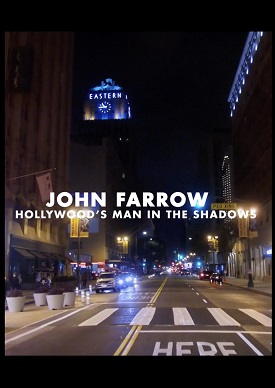
JOHN FARROW, MAN IN THE SHADOW
Australia, 2020, 96 minutes, Colour/black and white.
Directed by Claude Gonzalez, Frans Vandenberg.
This is a very interesting Australian documentary about Australian-born writer and director in Hollywood, John Farrow. He contributed to the writing of films from the late silent era into the 1930s, including Mutiny on the Bounty, but moving to direct his own films in the late 1930s, six in 1939 alone. But, as the title suggests, is not well known now.
The directors of this film have the advantage of access to footage from many of his films, especially those which were very well known in the 1940s and 1950s. There are extensive excerpts. The documentary also has the advantage of many talking heads, some prominent Australian directors including Bruce Beresford, Philippe Mora, Phillip Noyce, Ken Cameron as well is the French Bertrand Tavernier. And there are quite a number of historians and critics, especially Scott Murray and Charles high. (There are two sequences with the writer of this review, commenting on the devil in Alias Nick Beale and immoral commentary about John Farrow’s extramarital behaviour and Catholic response.)
In building up the story of John Farrow’s origins, Marrickville, Sydney, 1904, there are testimonies from various cousins, a touch of the folksy, but revealing the character of the director. The narrative is also taken up by Charles Farrow, Farrow’s third son who continues the commentary throughout the film. Audiences will then realise that Mia Farrow is one of his daughters. She did not collaborate with the film but the directors were able to get some television footage of interviews about her life and her family.
Farrow had an adventurous life, some turbulence in the family, his getting out of Australia, going to see, involved in all kinds of adventures – and which he drew for his writing and films. He jumped ship in San Francisco, married, began writing in Hollywood, divorced. However, some stability came to his life when he encountered Maureen O’Sullivan (and the film making comment about her upper class Irish background and its effect on her personality and her being a mother to so many children). There were seven children.
Farrow, originally Protestant, converted to Catholicism of his wife. One of the puzzling characteristics of Farrow is his interest in the history of the Catholic Church, his extensive writing on the church, on the history of the Pope’s, on his biography of Father Damien, the leper Priest on Molokai. There are also sequences of the churchgoing. However, Farrow had a severe personality, dominating and the family, Cpl punishment, somewhat tyrannical on the film sets. Later there is some revelation of his womanising.
So, while there is a substantial portrait of Farrow himself, the main thrust of the film is an admiration for his own films, the quality of his craft, his inventiveness in use of the camera, especially long takes which are well illustrated, and his working with actors.
His first prominent film was Five Came Back, an adventure which later generations would call a disaster movie, Wake Island dramatising the war in which he had served and had been injured. Oscar nominations. There is also a focus on the portrait of Hitler, by Bobby Watson, in The Hitler Gang. The list of his films in the IMDb shows that he was quite prolific at this time but the documentary having the opportunity to highlight only a few. Some notable films that are not included include To Years Before the Mast.
A great deal of attention is given to his films of the late 40s and early 50s, especially The Clock with Ramer land and Charles Laughton, with directors and critics and film historians highlighting the various qualities and techniques. There is his religious allegory, Alias Kapnick Beale. And two films with Robert Mitchum, Where Danger Lives, interestingly analysed and mention made of a seven minute take with Robert Mitchum and faith to mood. There is also His Kind of Woman, serious and comic, and interference from producer Howard Hughes.
While Farrow made a number of films in the first half of the 1950s, this documentary focuses on his western with John Wayne and Geraldine Paige, Hondo, filmed in 3-D. Farrow began directing Around the World in 80 Days, which he cowritten, but was fired by Mike Todd, the producer. However, the film won the Oscar for Best Film and Farrow for Best Screenplay. His last film was John Paul Jones, the documentary including footage taken in the background of the filming, his son Charles Farrow deciding that acting was not for him.
Much is made of Farrow stand against the inquisitorial methods of Sen McCarthy and the Communist accusations.
With illness, Farrow moved to television in the early 1960s, Maureen O’Sullivan meanwhile performing on stage in New York. He had a sudden heart attack and died at the age of 58.
An interesting documentary with a portrait, admiration for a filmmaker, and elements of critique.